Sturnus: Mobile Banking Malware bypassing WhatsApp, Telegram and Signal Encryption
20 November 2025
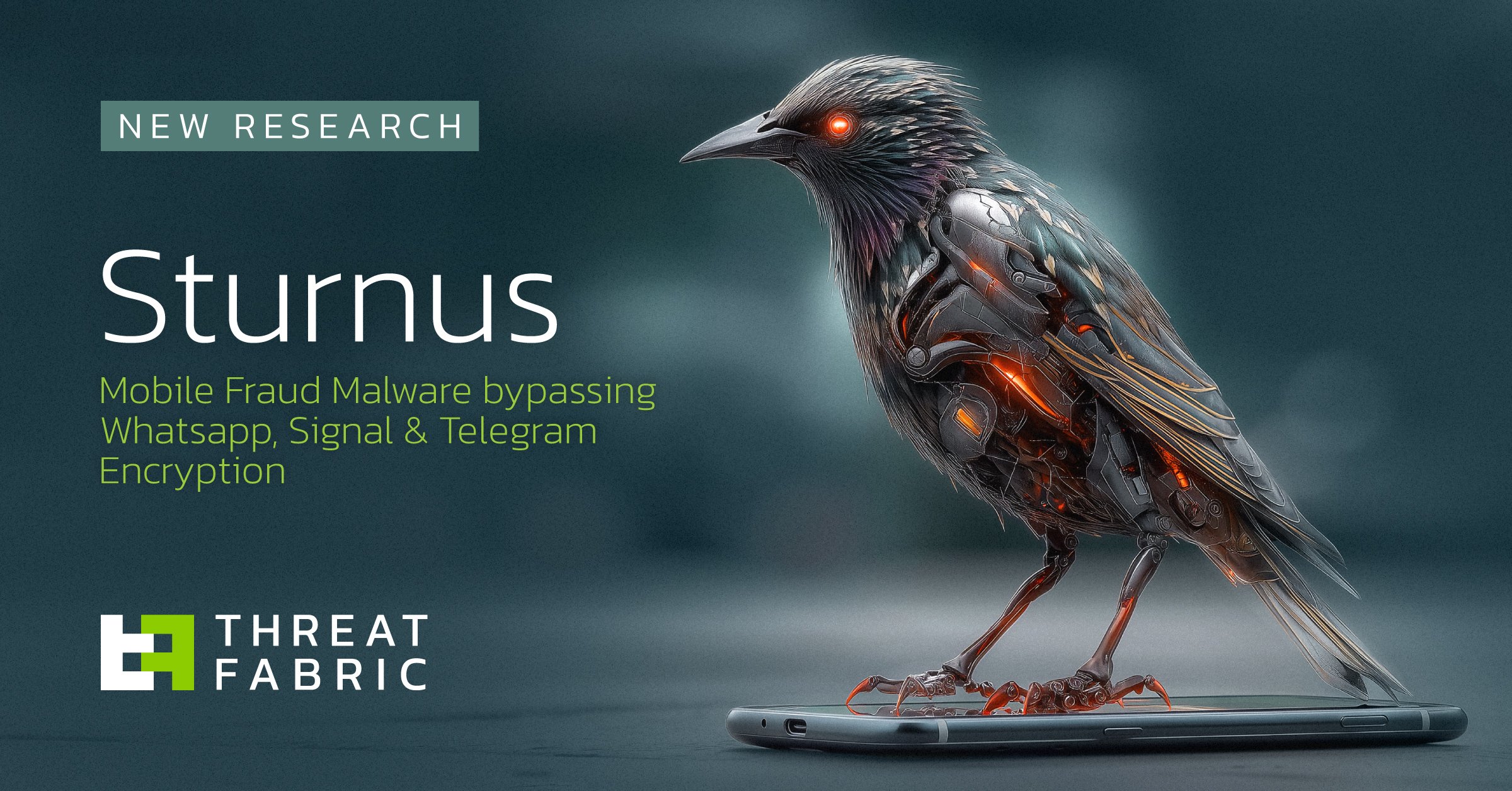
Jump to
MTI Security researchers have identified Sturnus, a privately operated Android banking trojan. This malware supports a broad range of fraud-related capabilities, including full device takeover. A key differentiator is its ability to bypass encrypted messaging. By capturing content directly from the device screen after decryption, Sturnus can monitor communications via WhatsApp, Telegram, and Signal.
The trojan can harvest banking credentials through convincing fake login screens that replicate legitimate banking apps. In addition, it provides attackers with extensive remote control, enabling them to observe all user activity, inject text without physical interaction, and even black out the device screen while executing fraudulent transactions in the background—without the victim’s knowledge.
An advanced threat in its early stages
While analysis indicates this operation is currently in a development or limited testing phase, Sturnus has already been configured with targeted attacks against financial institutions across Southern and Central Europe, suggesting preparations for a broader campaign. While we emphasize that the malware is likely in its pre-deployment state, it is also currently fully functional, and in aspects such as its communication protocol and device support, it is more advanced than current and more established malware families.
ThreatFabric mapped the capabilities of this new malware family according to the MITRE ATT&CK matrix, and you can find the corresponding techniques used:

Target and Victimology
Current evidence indicates that Sturnus.A is still in an evaluation and tuning phase, with relatively few samples and short, intermittent campaigns rather than sustained large-scale activity. The victimology so far points to targets primarily located in Southern and Central Europe, where we have observed region-specific overlay templates. In parallel, the malware’s behavior shows a clear focus on compromising widely used secure messaging platforms such as WhatsApp, Telegram, and Signal, suggesting that the operators are testing its ability to capture sensitive communications across different environments. Although the spread remains limited at this stage, the combination of targeted geography and high-value application focus implies that the attackers are refining their tooling ahead of broader or more coordinated operations.
The complex call of the Songbird
The malware’s layered and slightly chaotic mix of plaintext, RSA, and AES communications—switching unpredictably between simple and complex messages—reminds us of the Sturnus vulgaris, whose rapid, irregular chatter jumps between whistles, clicks, and imitations. This noisy and intricate pattern inspired the malware’s name.
The technical flow reflects this same structure: the malware communicates with its command-and-control server through both WebSocket (WSS) and HTTP channels, sending a combination of encrypted and plaintext data, with most plaintext appearing over WebSocket. Its protocol begins with an HTTP POST request to the endpoint to register the device using a placeholder payload. The server replies with a UUID (client ID) and an RSA public key. The malware then generates a 256-bit AES key locally, encrypts it using RSA/ECB/OAEPWithSHA-1AndMGF1Padding, and sends the encrypted key back, while storing the plaintext AES key on the device in Base64 form.
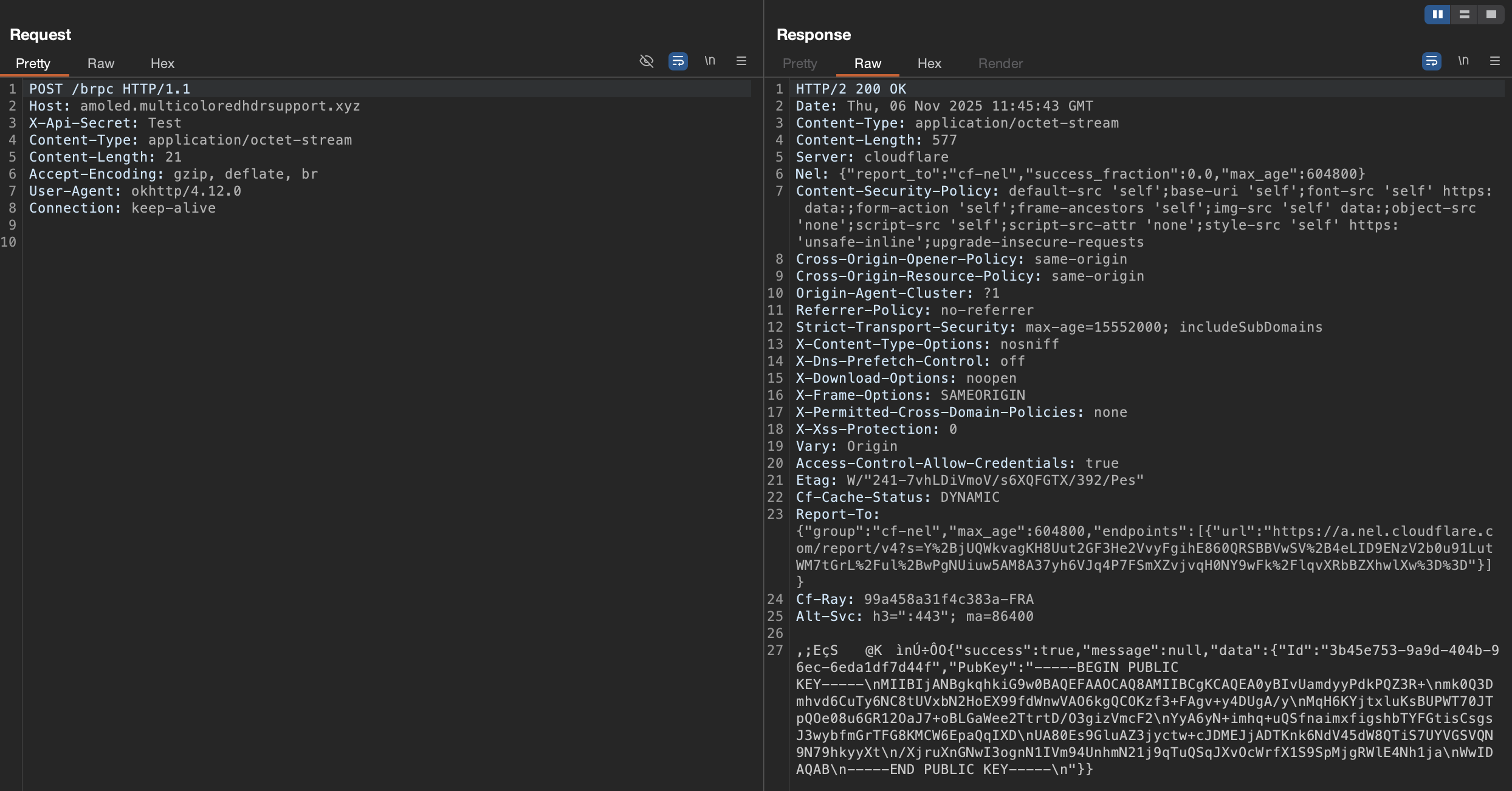
Once the key exchange is complete, all further communication is protected with AES encryption using AES/CBC/PKCS5Padding and a 256-bit key. For every message, the malware generates a fresh 16-byte initialization vector (IV), prepends it to the encrypted payload, and wraps the result in a custom binary protocol that includes a header with the message type, message length, and the client UUID. In parallel, the malware also establishes a WebSocket channel, which it uses to communicate directly with the bot during VNC sessions.
Here is the message structure, when encrypted:
 Capabilities
Capabilities
Data Exfiltration
The malware relies on two tightly integrated mechanisms—HTML overlays and accessibility-based keylogging—to capture and exfiltrate user credentials and other sensitive data. Its overlay engine maintains a persistent repository of phishing templates under /data/user/0/<malware_package>/files/overlays/, where each HTML file corresponds to a targeted banking application. When an overlay is triggered, the malware launches an activity containing a WebView configured with JavaScript, DOM storage, and a JavaScript bridge that intercepts and forwards any data the victim enters directly to the C2 server. Once the information is exfiltrated, the overlay for that specific target is disabled to reduce repetition and avoid suspicion.
The system also supports a full-screen “block overlay”, that allows attackers to hide their malicious activities from victims by displaying a full screen black overlay that blocks all visual feedback while the malware operates in the background .

Alongside overlays, the malware implements a comprehensive keylogging pipeline through the Android Accessibility Service. It processes events such as:
- TYPE_VIEW_TEXT_CHANGED
- TYPE_VIEW_FOCUSED
- TYPE_VIEW_CLICKED
- TYPE_WINDOW_CONTENT_CHANGED
to capture text as it is typed, track focus changes for context, and record UI interactions. Beyond simple keystroke logging, it continuously monitors the device’s UI tree and sends structured logs describing what is displayed on screen. This enables attackers to reconstruct full user activity even when screen capture is blocked by FLAG_SECURE or when network conditions prevent live video transmission. Together, these mechanisms give the operator a detailed, real-time picture of the victim’s actions while providing multiple redundant paths for data theft.
These capabilities are also used by the malware to programmatically steal PINs and Passwords to easily unlock the device.
Messaging Apps control
Sturnus, in addition to banking applications, also monitors the foreground app and automatically activates its UI-tree collection whenever the victim opens encrypted messaging services such as WhatsApp, Signal, or Telegram.
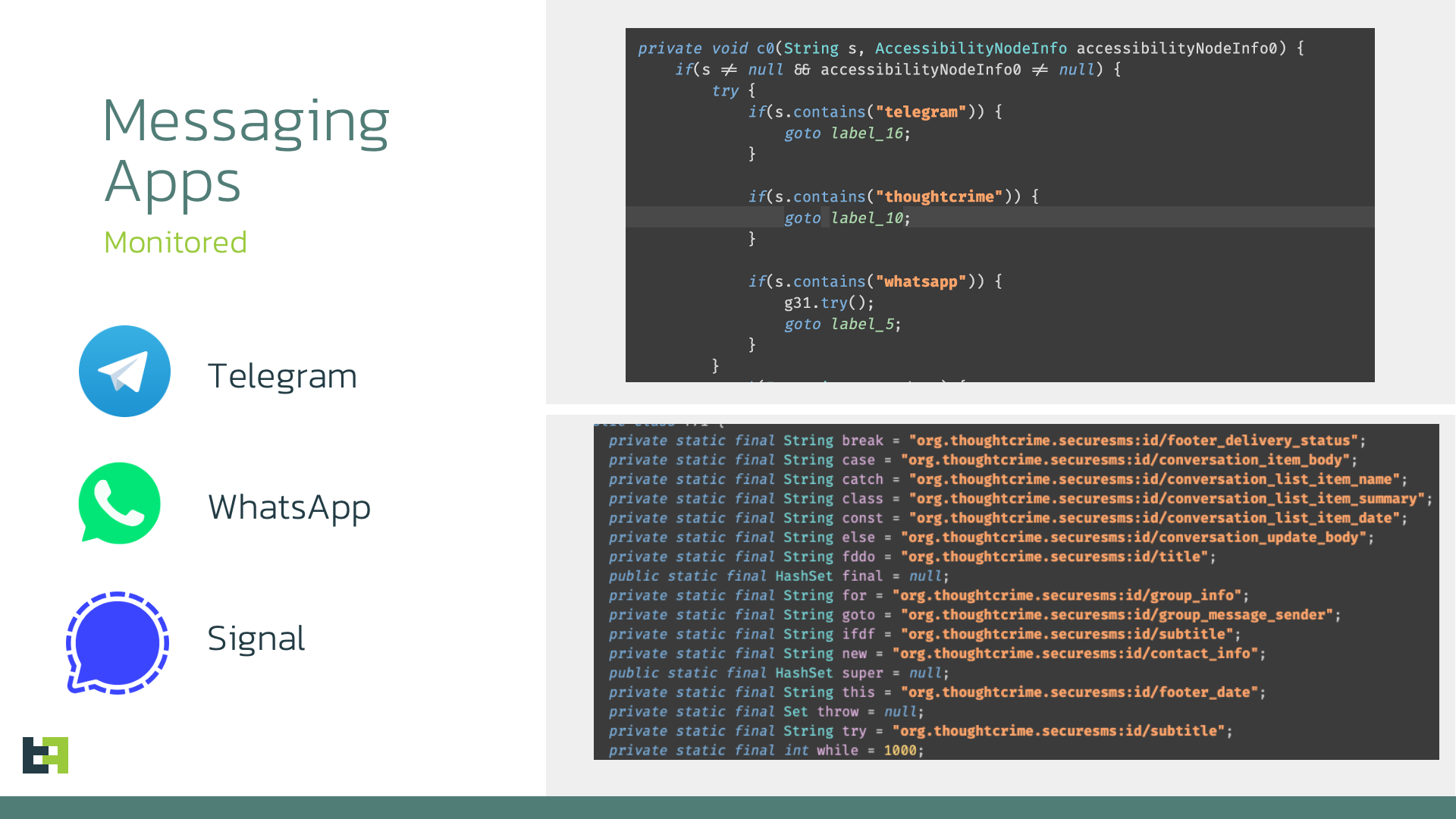
Because it relies on Accessibility Service logging rather than network interception, the malware can read everything that appears on screen—including contacts, full conversation threads, and the content of incoming and outgoing messages—in real time. This makes the capability particularly dangerous: it completely sidesteps end-to-end encryption by accessing messages after they are decrypted by the legitimate app, giving the attacker a direct view into supposedly private conversations. The user sees a secure interface, but from the moment the device is compromised, every sensitive exchange becomes visible to the operator, with no cryptographic protection left to rely on.
Remote Control
Sturnus supports full remote sessions, letting operators interact with the victim’s device using two complementary screen-capture techniques that provide redundancy across Android versions and permission states. Its primary method relies on the system’s display-capture framework to mirror the device screen in real time, while a fallback mechanism uses Accessibility-based screenshots when standard capture is blocked. Both approaches produce continuous visual streams that can be scaled, throttled, or reconfigured remotely depending on bandwidth and operational needs. Screen data is converted into a native framebuffer and encoded for transmission, enabling responsive remote interaction. Then, the management of the session is handed to a native library, which implements the VNC RFB protocol, encoding frames for transmission to connected clients.
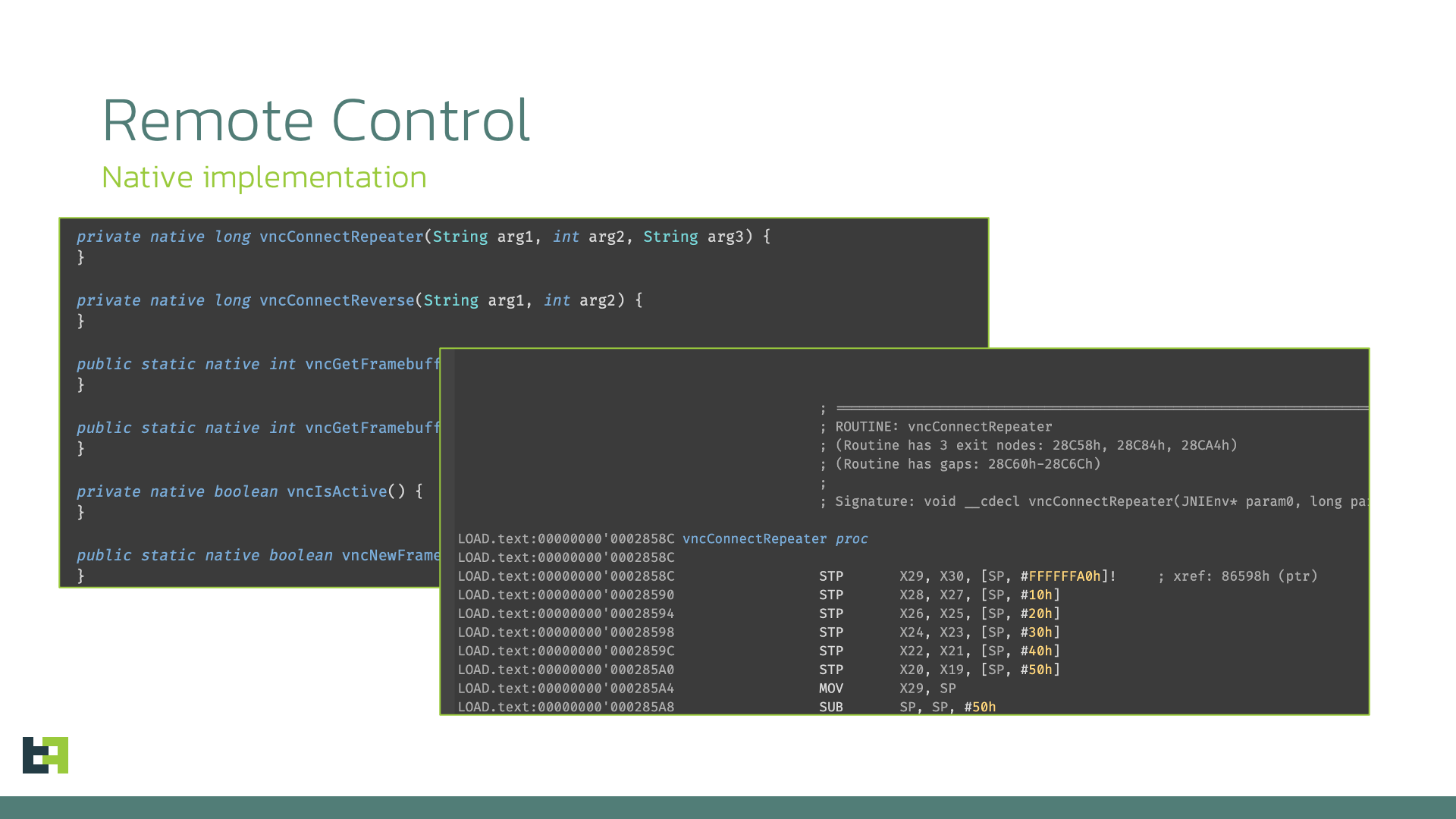
In parallel with pixel-based streaming, Sturnus exposes a second, highly efficient control layer based entirely on Accessibility-derived UI information. Instead of sending images, it transmits structured descriptions of every visible interface element, allowing attackers to map the entire screen, understand its layout, and issue precise actions such as clicks, text input, scrolling, app launches, or permission confirmations. This method consumes minimal bandwidth, works without triggering screen-capture indicators that would normally appear, and remains fully operational when elements are off-screen or protected by security flags.
Together, the visual stream and the UI-tree control channel give attackers persistent, covert, and fine-grained control over an infected device. Here is a screenshot of data exfiltrated by Sturnus, and an example of how this data could look on the control panel of the criminals (example taken from another banking malware with the same feature):
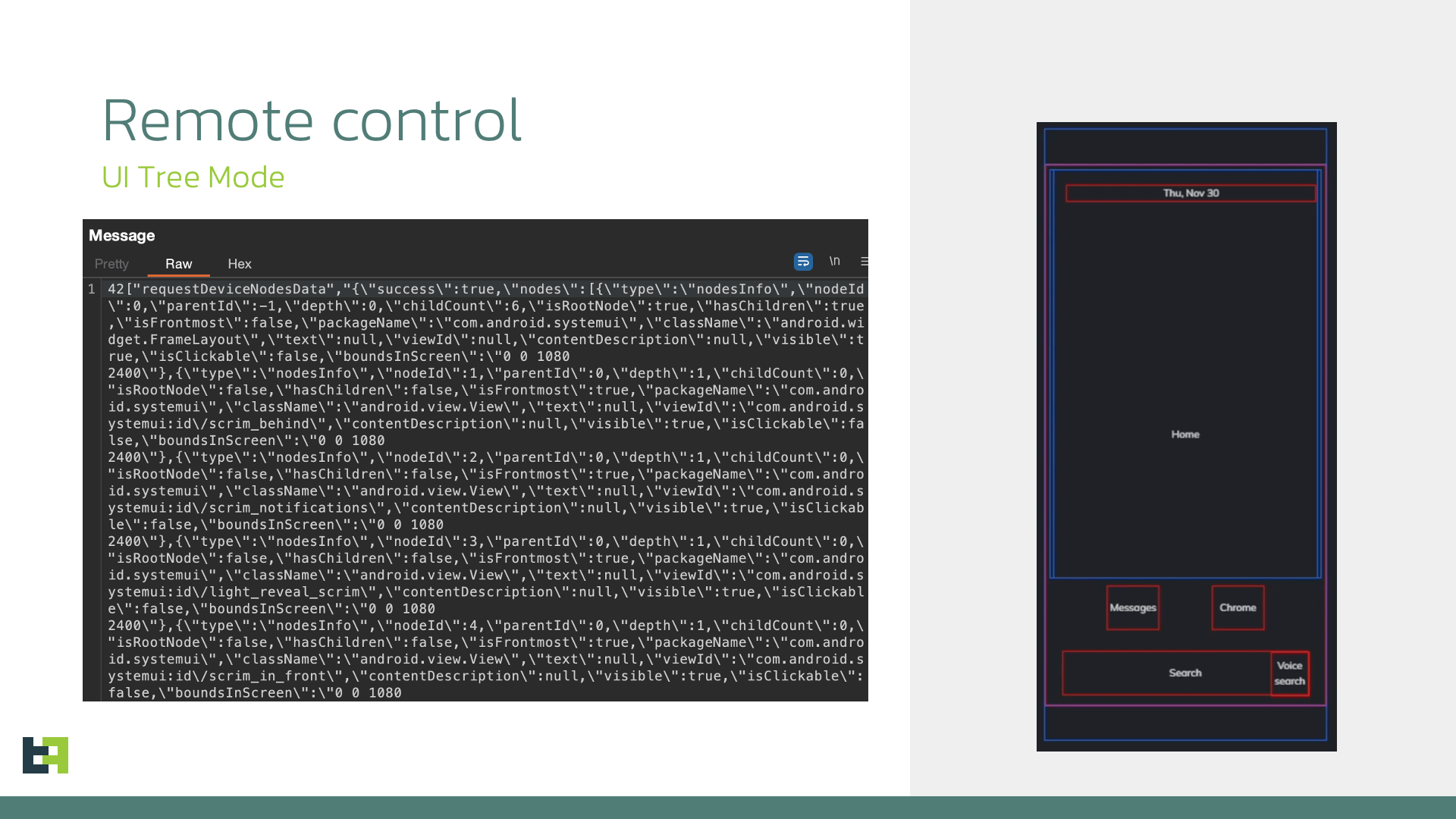
Here is the full list of supported actions, which often accept parameters such as coordinates or node identifiers:
|
Value |
Description |
|
buttonAction |
System navigation control |
|
clickNode |
Click specific UI element |
|
textSender |
Inject text into focused field |
|
gensureScroll |
Execute swipe/scroll gesture |
|
lastClickedNode |
Click multiple nodes in sequence |
|
nodesInfo |
Enumerate all UI elements |
|
enableBlackScreen |
Hide screen from victim |
|
disableBlackScreen |
Remove black screen overlay |
Environment monitoring
Sturnus reinforces its persistence by securing Android Device Administrator privileges and actively defending them. Once granted, these privileges allow the malware to monitor password changes, unlock attempts, and lock-screen activity, sending each event to the command-and-control server with precise timestamps. The same privileges let it lock the device remotely and, more importantly, make itself significantly harder to remove. Whenever the user navigates to settings screens that could disable its administrator status, the malware detects the attempt through Accessibility monitoring, identifies relevant controls, and automatically navigates away from the page to interrupt the user. Until its administrator rights are manually revoked, both ordinary uninstallation and removal through tools like ADB are blocked, giving the malware strong protection against cleanup attempts.

Alongside its administrator defenses, Sturnus maintains extensive situational awareness through a broad environmental monitoring subsystem designed to ensure long-term resilience on the device. Twelve internal broadcast receivers and a dedicated security-checking thread continuously track system activity, connectivity changes, power and battery states, SIM transitions, app installation events, USB behavior, and signs of forensic probing or rooting. It also monitors security-relevant settings such as developer mode, ADB debugging, SELinux state, and the device’s patch level, reporting any change immediately to the operators.
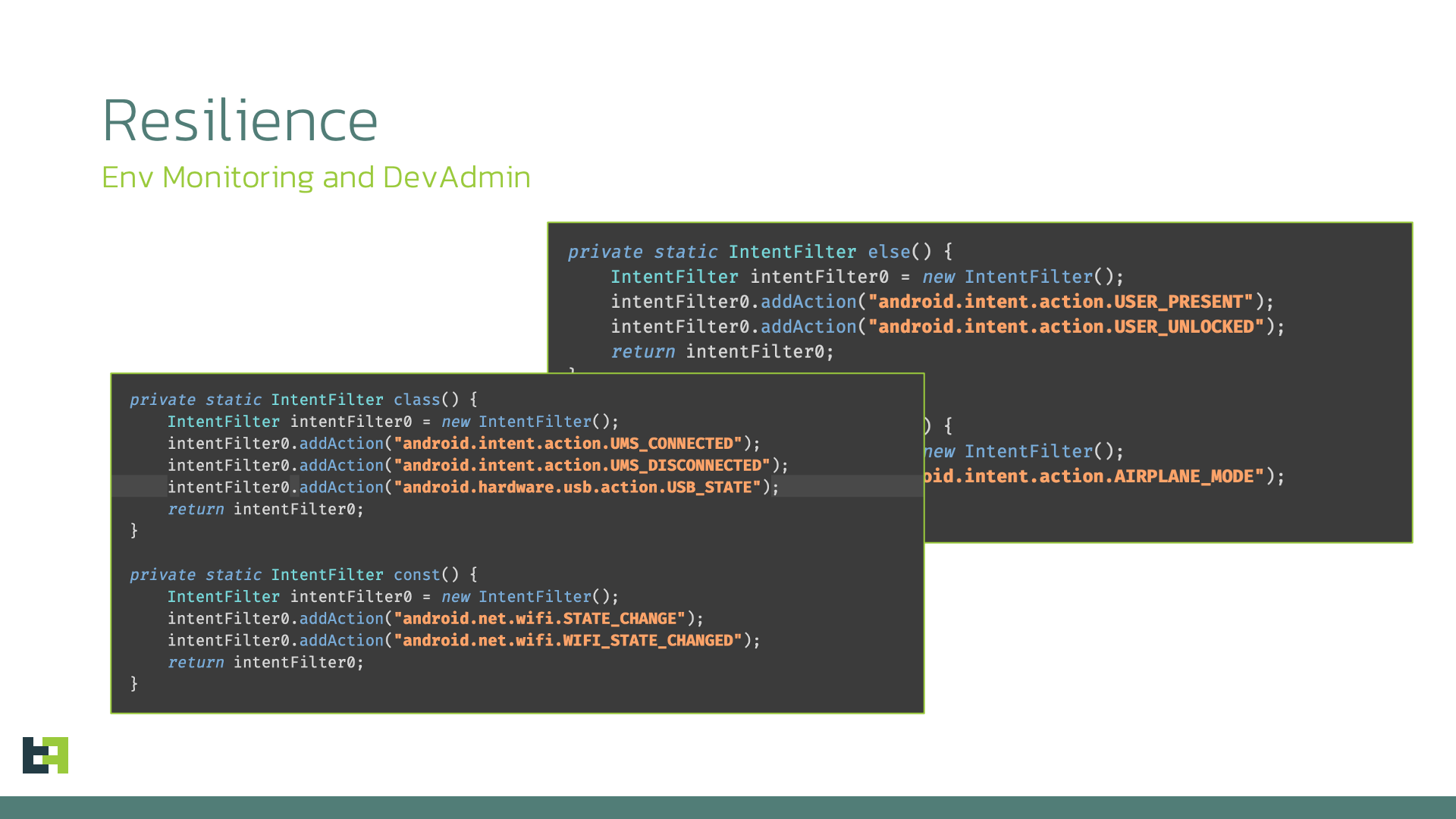
By collecting sensor information, network conditions, hardware data, and installed-app inventories, the malware builds a detailed device profile that helps attackers assess risk, adapt their tactics, and detect analysis environments or emulators. This continuous feedback loop allows Sturnus to persist on the device, avoid exposure, and remain operational even as conditions change around it.
Conclusions
Sturnus represents a sophisticated and comprehensive threat, implementing multiple attack vectors that provide attackers with near-complete control over infected devices. The combination of overlay-based credential theft, message monitoring, extensive keylogging, real-time screen streaming, remote control, device administrator abuse, and comprehensive environmental monitoring creates a dangerous threat to victims' financial security and privacy.
The malware's architecture demonstrates advanced evasion capabilities through code obfuscation, complex and solid communication encryption, and active interference with security controls. The persistent C2 connection via WebSocket enables real-time command and control, allowing attackers to adapt their tactics dynamically based on device state and victim behavior.
Appendix
Bot Commands
|
Commands |
Description |
|
APP_HIDE |
Hides the specified app from the user. |
|
APP_UNHIDE |
Makes a previously hidden app visible again. |
|
HIDE_ICON |
Removes or hides the app’s launcher icon. |
|
APP_SUSPEND |
Temporarily disables an app so it cannot run. |
|
APP_UNSUSPEND |
Re-enables an app that was previously suspended. |
|
APP_UNINSTALL |
Uninstalls the specified app from the device. |
|
SEND_NOTIFICATION |
Displays a notification on the device. |
|
PING |
Sends a heartbeat to confirm the malware is active. |
|
LOCK_SCREEN |
Forces the device screen to lock. |
|
UNLOCK_SCREEN |
Attempts to unlock or bypass the screen lock. |
|
OPEN_URL |
Opens a specified URL on the device. |
|
KILL_SELF |
Forces the malware to remove or terminate itself. |
|
APP_INSTALL |
Installs an app. |
|
REFRESH_DELAY |
Updates internal timing or command polling intervals. |
|
LAUNCH_APP |
Opens or launches a specified application. |
|
FORCE_STOP_APP |
Forces an app to stop running. |
|
CALL_PHONE |
Initiates a phone call to a given number. |
|
SEND_SMS |
Sends an SMS message to a specified number. |
|
DELETE_ALL_SMS |
Deletes all SMS messages on the device. |
|
DELETE_SMS |
Deletes a specific SMS message. |
|
DELETE_ALL_CALLS |
Deletes the entire call log. |
|
DELETE_CALL |
Deletes a specific call entry. |
|
ADD_NEW_CONTACT |
Adds a new contact to the address book. |
|
DELETE_ALL_CONTACTS |
Removes all contacts from the device. |
|
DELETE_CONTACT |
Removes a specific contact. |
|
RING_BUZZ_DEVICE |
Makes the device ring or vibrate. |
|
REFRESH_ALL_DATA |
Forces complete reloading or syncing of malware data. |
|
START_VNC |
Starts a remote-control VNC session. |
|
STOP_VNC |
Stops an active VNC remote-control session. |
|
ENABLE_BLACK_OVERLAY |
Shows a black screen overlay to hide activity. |
|
DISABLE_BLACK_OVERLAY |
Removes the black screen overlay. |
|
ENABLE_UPDATE_OVERLAY |
Shows an overlay indicating an update to mask actions. |
|
DISABLE_UPDATE_OVERLAY |
Removes the update-style overlay. |
|
START_HVNC |
Starts a hidden VNC session (invisible remote control). |
|
STOP_HVNC |
Stops the hidden VNC session. |
|
RELOAD_INJECTS |
Reloads phishing/overlay inject templates. |
|
ENABLE_INJECT |
Activates a specific phishing/overlay injection. |
|
PIN_SOLVER |
Attempts to bypass or solve the device PIN. |
|
REQUEST_PERMISSION |
Prompts the user for a required permission. |
|
DISABLE_INJECT |
Deactivates a specific phishing/overlay injection. |
|
HIDE_SMS |
Hides SMS messages from the inbox. |
|
UNHIDE_SMS |
Restores previously hidden SMS messages. |
|
PIN_SOLVER2 |
Alternate or updated method for bypassing device PIN. |
Indicators of Compromise
|
SHA-256 |
Package name |
Application name |
C2 |
|
045a15df1121ec2a6387ba15ae72f8e658c52af852405890d989623cf7f6b0e5 |
com.klivkfbky.izaybebnx |
Google Chrome |
amoled[.]multicoloredhdrsupport[.]xyz |
|
0cf970d2ee94c44408ab6cbcaabfee468ac202346b9980f240c2feb9f6eb246d |
com.uvxuthoq.noscjahae |
Preemix Box |
walnut[.]almondcollections[.]com |